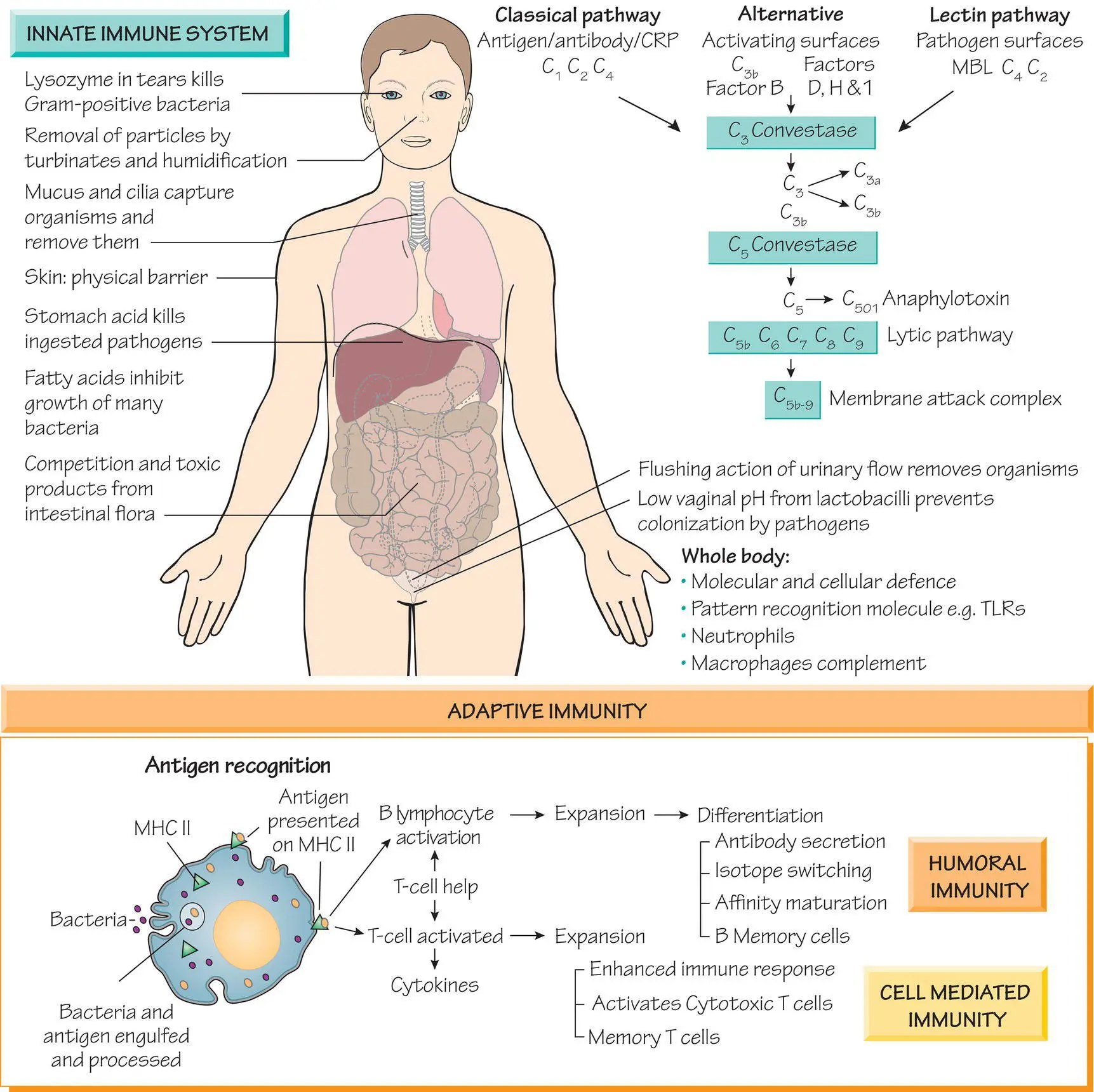Gram‐negative bacilli(including the family Enterobacteriaceae) can be part of the normal flora of humans and animals, and in the environment. They include many pathogenic genera: Salmonella , Shigella , Escherichia , Proteus and Yersinia (see Chapters 28and 29). Pseudomonas and Burkholderia are environmental saprophytes that are naturally resistant to antibiotics and are important healthcare associated pathogens (see Chapter 31). Legionella lives in the environment in water but can cause human infection if conditions in the built environment allow it to gain a foothold (see Chapter 31).
Spiral bacteriainclude the small gastrointestinal Helicobacter that colonizes the stomach, and may lead to gastric ulcers, duodenal ulcers and gastric cancer. Campylobacter spp. can cause acute diarrhoea (see Chapter 33). The Borrelia may cause a chronic disease of the skin joints and central nervous system, Lyme disease ( Borrelia burgdorferi ), or rarely relapsing fever ( Borrelia duttoni and Borrelia recurrentis ). The Leptospira are zoonotic agents that cause an acute meningitis syndrome that may be accompanied by renal failure and hepatitis. The Treponema include the causative agent of syphilis ( Treponema pallidum ) ( Chapter 33).
Mycoplasmaand Chlamydiaare responsible for common respiratory and sexually transmitted infections ( Chapter 33).
Rickettsiaare the agents of typhus and rarer severe infections (see Chapter 32).
2 Innate and acquired immunity

The innate immune system, which consists of the normal flora, physical barriers such as the skin, antibacterial proteins and phagocytic cells, is an important defence mechanism against infection. Many responses to ‘harm’ are detected by pattern recognition molecules such as the Toll‐like receptors (TLRs), which trigger cascades that activate phagocytes and the immune response. For example, TLR‐4 recognizes lipopolysaccharide and TLR‐9 recognizes unmethylated CpG dinucleotides. The main components of the system are listed in the Table in the next chapter. Variation in the expression/composition of each component affects an individual’s resistance to infection.
Neutrophils and macrophages ingest particles, including bacteria, viruses and fungi. Opsonins (e.g. complement and antibody) may enhance phagocytic ability; for example, S. pneumoniae are not phagocytosed unless their capsule is coated with an anti‐capsular antibody. The action of macrophages in the reticuloendothelial system is essential for resistance to many bacterial and protozoan pathogens, such as S. pneumoniae and malaria. Congenital deficiency of neutrophil function leads to chronic pyogenic infections, recurrent chest infections and bronchiectasis. Following splenectomy, patients have defective macrophage function and diminished ability to remove capsulate organisms from the blood.
Complement and other plasma proteins
Complement is a system of plasma proteins that collaborate to resist bacterial infection, which is activated by antigen–antibody binding (the classical pathway) or by direct interaction with bacterial cell wall components (the alternative pathway). The products of both processes attract phagocytes to the site of infection (chemotaxis), activate phagocytes, cause vasodilatation and stimulate phagocytosis of bacteria (opsonization). The final three components of the cascade form a ‘membrane attack complex’ that can lyse Gram‐negative bacteria. Complement deficiencies render patients susceptible to acute pyogenic infections, especially with Neisseria meningitidis , Neisseria gonorrhoeae and S. pneumoniae .
Multiple plasma proteins work to protect against infection and some of these increase very significantly in response to inflammation; these are known as acute phase proteins. Some of these are antibacterial e.g., mannose‐binding protein and can activate complement. C‐reactive protein (CRP), activates complement when it binds to bacteria and, uniquely there are no fully deficient patients. Other proteins such as transferrin sequester iron that is vital for invading organisms, and limits the amount available them.
The adaptive (specific) immune response
The adaptive immune response is essential for defence against infection. This complex system provides immune responses to individual microorganisms. Organisms express a multiplicity of antigens that are displayed on the surface of the pathogen and detected by cells of the immune system. Antigens depend on the tertiary structure of the surface proteins or polysaccharides. Short peptide or carbohydrate sequences bound by immune responsive cells are called epitopes. These immunogenic epitopes are organism sub‐components such as surface proteins, parts of toxin molecules or virus proteins expressed on cell surfaces. Different epitopes stimulate varying components of humoral and cell immunity. Organisms each contain many antigens, within which are many different epitopes.
The adaptive immune response comprises two main components: the humoral and cellular immune system.
In the humoral response, B‐lymphocytes develop into clones of antigen‐producing cells, elaborating antibodies against antigens of the invading organism. Repeated exposure allows for increasing maturation of the response with the initial IgM response being replaced by IgG and IgA. Clones of B‐cells produce antibodies that recognize and bind to unique pathogen antigens and inhibit key possesses. This process can be critical for recovery from invasive infection: the lysis stage of pneumococcal pneumonia (see Chapter 20). We also use this in vaccination to protect against specific diseases that generate memory B‐cells, most optimally when the disease depends on a single antigen (e.g., toxin in tetanus) or a pathogen with a single serotype (e.g. measles) (see Chapter 13).
In the cellular response, clones of cytotoxic lymphocytes develop, which can destroy cells bearing the foreign antigens, which results in control of infection. T‐cells can interact with other cells of the system to enhance defences by releasing molecules such as cytokines that can, for example, activate macrophages and increase killing efficiency.
The overall effectiveness of both the humoral and the cellular immune response depend for their amplification on CD4 helper T‐lymphocytes. In their absence of effective CD4 cells as in the case of HIV infection, new infections cannot be overcome by cellular immune responses, and new antibody responses are inefficient.
On occasion, the immune response can be damaging. Sepsis is associated with immune dysregulation and can result in multi‐organ failure. Although not fully understood, pattern‐recognition receptors (e.g., Toll‐like receptors) trigger the release of pro‐ and anti‐inflammatory mediators. Multiple cytokines e.g., tumor necrosis factor (TNF) and others, activate complement and clotting cascades generating micro‐thrombi. Breakdown of pathogen components can cause uncontrolled stimulation of the system, resulting in shock and sudden death (see Chapter 55). Uncontrolled cellular responses in, for example, tuberculosis can cause tissue damage in lung cavitation. Another example is Immune Reconstitution Inflammatory Syndrome, which is an inflammatory condition that occurs when a patient experiences a recovery of immune activity against the antigens of an established infection that had previously been suppressed. It is described in HIV‐infected patients after starting anti‐retroviral therapy, but also occurs when patients recover from general or pathogen‐specific immunosuppression. It presents with fever, increased new lymphadenopathy, skin inflammation, pleural or pericardial effusions, ascites, shock or sudden death (see Chapter 53).
Читать дальше











